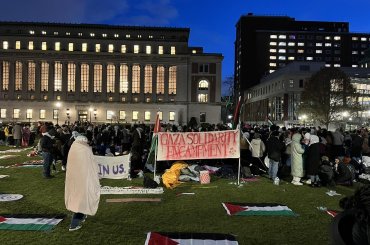
As I’ve written, in a story about a viral video of an Israeli soldier in Hebron who threatened Palestinian youths, The New York Times Jerusalem Bureau Chief Jodi Rudoren chose to initially report, unchallenged and with no attribution, a claim that a Palestinian youth in the video “had brass knuckles.” After a video emerged showing convincingly that the youth was holding prayer beads and not brass knuckles, The New York Times issued a correction with no mention of the video and that I believe serves to cast further suspicions on the youths and seems to confer The New York Times’ legitimacy to an Israeli military investigation of “whether any of the youths had weapons.”
Added information raised more questions about the original, uncontested reporting of the claim. Issa Amro, a Palestinian activist from Youth Against Settlements in Hebron who published the initial videotape and then the second one, responded to me by email that he had told Ms. Rudoren that the youth did not have brass knuckles in an interview conducted before her original article was published, but this denial did not appear in her original article.
The discussion of this single New York Times story, however, is only significant when seen as part of a larger pattern by the newspaper of sometimes marginalizing and silencing Palestinian views, while privileging Israeli perspectives, a pattern that is common in US mainstream media in general.
I sent a link of my Mondoweiss post to a number of New York Times Editors and Jerusalem Bureau Chief Jodi Rudoren and received a response from Senior Editor for Standards Greg Brock, who wrote among other things:
“We erred in one key way: we should have attributed our statement about the brass knuckles — a point you made in your original complaint. So that was the ultimate goal of the correction. And we used the language we have used many times: we overstated what was definitively known about the situation. — at the time we published the article.”
“Were we able to go back and start over, we would add attribution. But we would not have deleted the information because reports of brass knuckles were in fact part of the news story.” …
“I am sorry that you do not agree with the way we handled this, or with our decision. But for correction purposes, we are not going to revisit it further. I consider this issue closed and plan no further responses.”
With no expectation of any further response or of any changes, I’ve written back to those other New York Times editors asking why, if the goal of the correction was to add attribution, did they not satisfy themselves with just the first two sentences of the correction, saying: “An earlier version of this article overstated what is known about one of the Palestinian teenagers pictured in the video. Local media initially reported that he had brass knuckles, but the youth later said he was holding prayer beads instead.” I questioned why they then felt compelled to add this closing sentence, which both revives and broadens accusations against the youths involved and seems to defer to and put The New York Times’ weight behind an Israeli military investigation: “The Israeli military is still investigating the episode, including whether any of the youths had weapons.” As a side note, that sentence has since been put in parenthesis by The New York Times.
I’ve also sent The New York Times staff the excerpt below from Israeli journalist Amira Hass’s article today about that Israeli military investigation that The New York Times felt it so important to note was not yet completed in their correction:
The IDF Spokesperson’s Unit also chose not to respond to questions concerning the arrest of Saddam Abu Sneinah, the youth from the video who was holding prayer beads, and who Adamov said was holding brass knuckles and supposedly threatening him, the poor guy. Threatened? In a settler area, in front of a checkpoint manned by armed soldiers? Next to a military camp? Chief of Staff Benny Gantz – With soldiers who are so weak, insecure and delusional, you should be very worried.
Soldiers beat Abu Sneinah when they arrested him. The IDF Spokesperson did not deny or respond to this assertion. Because it’s the norm. Soldiers beat handcuffed Palestinian detainees. It’s part of the dehumanization, of the routine violence. It’s gone on for 47 years (the occupation), for 66 years (the State of Israel), and we’re not done yet. Nor did the IDF Spokesperson issue a response when asked whether the fact that such beatings are the norm meant the commanders support the beating of detainees. The soldiers kept Abu Sneinah handcuffed and blindfolded for an entire night, on a concrete floor with no mattress. The IDF Spokesperson did not deny or respond when asked if this was torture. The IDF Spokesperson did not identify either the commander who ordered Abu Sneinah’s arrest or the commander who was responsible for the atrocious conditions in which he was kept. The IDF Spokesperson also did not respond when asked why, when Abu Sneinah was released, after 24 hours, he was rearrested by different soldiers at the checkpoint near Shuhada Street. He was held for another hour, and the heroic soldiers beat him some more.
I wonder if the Israeli military has now completed its investigation of whether any of the youths had weapons, following their two beatings, and handcuffing and blindfolding of Saddam Abu Sneinah overnight on a concrete floor, or if that investigation is still on-going?


Thanks for your persistence and good work. It must be very difficult to persevere in the face of such mendacity.
Patrick you’re doing Lord’s Work.
The systematic pro-Israel/pro-Zionist bias is deep within the culture of the NYT.
We won’t be able to change that from the outside.
But what we can do, at the very least, is to inform readers of the Times’ and people who occassionally use it as a reference on I/P that such a bias exists, that it is pervasive and that their editors are very defensive about it.
By counting all the instances, we’re able to point to a body of work which anyone can feel free to go through and judge for themselves if they agree or disagree with the conclusion that the NYT does have an ingrained reflex to privilege Israeli army and ministerial sources over any other dissenting voice. As you go through all these articles, it is increasingly difficult to deny it.
Much of social life is about the maintenance by those in power of subordination. This practice is called “conservatism”. Sometimes it is called “reaction” and its practitioners are deemed “reactionary”. This means that the rich act to keep the poor “in line”. Whites in some places and times have worked to keep “blacks” “in line” and to discourage civil rights and voting rights. Companies act to keep workers “in line” and to discourage the labor movement.
The police seem usually to act on behalf of the powerful in the society which pays them. “Liberation Theology” is a name for a religious plan to adjust a power imbalance. Revolution is concerted action to change power relationships. “Reform” which always meant politics aimed at changing power relationships, may once have meant something like “power to the people” but nowadays masks conservative efforts to take power back for the white, the rich, males over family, employers over employed, police over policed, etc.
These Israeli police and soldiers are part of a mechanism which sees its job as keeping Palestinians subordinate, suppressing insubordination, frightening Palestinians.
So of course they beat Palestinians up, as a matter of course. NYT and others (AIPAC comes to mind) see nothing wrong with this, go along, because they are part of the power-holders in USA’s power-hierarchy.
So it goes.
And “liberals” in the USA who might object to such behavior by police in the USA (NB: “might object”) don’t object when it happens in Israel, which the USA’s pols have determined must come out on top, always.
Read “The Reactionary Mind” by Corey Robin.
The NYT has consistently shown ignorance when it comes to Israel’s crimes, pretends it does not happen, and exaggerates the situation when it comes to any involvement with a Palestinian, and as we see here, is able to twist a story around, and cast suspicion on the victim, because it is part of the zionist devoted media. The New York Times keeps doing what they are all expected to. Perhaps AIPAC has made sure they toe the line, and not cross it, when it comes to criticism of Israel, even if reporting the truth, or maybe a journalist who wants to do so, is afraid of being labelled an anti-Semite and lose his job, either way, it is disgraceful that the NYT like all other zionist media, seems to find it easy to criticize the President, leaders, the entire world, but NOT even a whisper of criticism, when it comes to a rogue state that is guilty of a military occupation, and whose out of control armed forces, and illegal settlers, show continuous brutality towards unarmed civilians, including kids. Strange phenomenon in the US, no?
“‘NYT’ correction privileges Israeli military investigation over firsthand Palestinian accounts”
Of course. The NYT isn’t a journalistic publication when it comes to Zionism. They’ve chosen sides. I expect neither fairness nor accuracy from them. I expect them to frame everything as far “pro-Zionism” as possible, in every regard. They’re hacks, pure and simple.